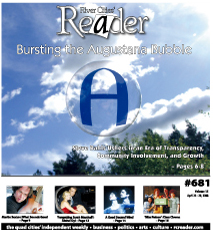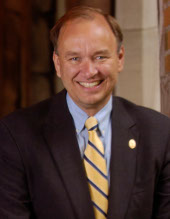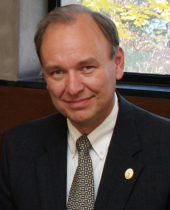 Peter Kivisto offers this observation about Augustana College President Steven C. Bahls.
Peter Kivisto offers this observation about Augustana College President Steven C. Bahls.
"Somebody'd have a new book, and the next thing you know, you'd have a little letter from him congratulating you," said Kivisto, the Richard Swanson Professor of Social Thought at Augustana and the past chair of the faculty senate. "That's on the cheap, but it meant a lot to us."
It's an admittedly minor thing, but it speaks to Bahls' style, and style counts for a lot in leadership. The Rock Island liberal-arts college is not an autocracy, and the power of its president to create change largely rests with his ability to inspire and guide, particularly the faculty and the board of trustees.
"A president needs to support those who identify meaningful changes at the college," Bahls said in an hour-long interview earlier this month.
So congratulatory letters aren't evidence of Bahls' effectiveness, but a way of understanding how he's effective.
Kivisto said that Augie's current president has been more outgoing than his predecessor, Thomas J. Tredway, by "building community ties that have really been frayed and fragile for a long time." In ways large and small, "we're making an effort to say that the institution is committed to the Quad Cities."
Dr. Paula Y. Arnell, an Augustana board member and a Moline pathologist, gave one example. In an e-mail, she wrote: "An important tool in achieving the goals of the strategic plan has been the president's use of Dahl House, Steve's home on campus. Several days a week he has evening meetings with students, faculty, alumni, and friends of the college. This home ... provides a location for strengthening campus ties and forging community and alumni connections."
Jon Clauss, associate professor of mathematics and the current chair of the faculty senate, called Bahls "highly proactive. Very engaged with all of the communities that he works for," including the faculty, students, alums, the board of trustees, and anybody else interested in the college. Bahls is a "very dynamic, very high-energy guy. ... He knows how to listen."
Bahls has also been interested in community involvement in other ways - from his participation on several local boards to encouraging students to pursue "service learning" through internships with local organizations.
Under Bahls' tutelage, Augustana is also enhancing its partnership with Longfellow Elementary, just a few blocks east of the college's campus.
"Their education department is sitting down with us and redefining how we're going to teach at Longfellow school," said Rick Loy, superintendent of the Rock Island/Milan school district. "It's going to have what we call an integrated liberal-arts approach to educating the children, which is a step in a different direction. ... It's bringing new life, new energy, new leadership to the school."
As Bahls said: "What people have regarded to be the Augustana bubble has burst."
A Natural Flow
For concrete evidence of Bahls' impact, look no further than what Augustana calls its "dashboard indicators" (http://www.augustana.edu/x8096.xml).
 This collection of nearly 40 statistics does two things: It shows Augustana's progress over Bahls' nearly five-year tenure, and it's a demonstration of his transparency. "He lays stuff out there for people," Kivisto said.
This collection of nearly 40 statistics does two things: It shows Augustana's progress over Bahls' nearly five-year tenure, and it's a demonstration of his transparency. "He lays stuff out there for people," Kivisto said.
The statistics include everything from the college's bond rating to the size of its applicant pool to its class sizes to its operating margin. As the college prepares to announce the public phase of a $100-million capital campaign early next month - $80 million has already been raised, $35 million of that from its 40-member board - these numbers show that Augustana under Bahls is making significant progress on goals outlined in the strategic plan that was approved in January 2005.
According to the indicators, Augustana's student body has grown (from 2,288 in 2003 to 2,516 in 2007) while its student-to-faculty ratio has dropped, and the percentage of classes with fewer than 20 students has grown. The college's endowment has risen from $87 million in 2003 to $119 million in 2007. The percentage of students participating in internships, study-abroad programs, and research projects has each grown.
These are not insignificant issues. To thrive, Augustana must adapt. As Clauss said, "The demographic of college-age kids is about to fall off a cliff, especially in Illinois and other parts of the Midwest. So we face some very big challenges to maintain the class size that we have." Nearly 90 percent of Augustana's students come from Illinois, and only 10.5 percent are racial minorities. (Although the college's percentage of racial-minority students is up from 7.5 percent in 2003, "we're far from being where we'd like to be," Bahls said.) The college needs to expand its geographic and sociological reach, Clauss said, and build competitive advantages over other liberal-arts schools.
"We do have to figure out what it is that students need to be engaged citizens in the 21st Century ... that can prosper ... ," Clauss said. "We have to figure that out first, and move a monolithic curriculum in a direction that's going to allow us to provide that sort of training."
Bahls concurred, and added that the college must also find new ways to attract and retain faculty members, because it's getting harder to find qualified candidates for openings. "There is a shortage of Ph.D.s in many of the areas where Augustana College has traditional strengths," he said, such as the sciences, business, and accounting.
One challenge that Bahls faces is meeting the needs of contemporary students while remaining true to the college's Lutheran roots.
"The values and the core of Augustana are the same," Bahls said of his tenure. "After all, Augustana's 148 years old, and I think it's dangerous to come in and in five years change a successful institution. But I think some of the aspects of Augustana have changed."
The Reverend Peter W. Marty, senior pastor of St. Paul Lutheran Church in Davenport and an Augustana board member for the past three years, called Bahls a "visionary" but stressed that the school hasn't changed in any fundamental ways. "It's strengthening its strengths," he said. "It's not a remade institution by any stretch."
Bahls is just the eighth president that Augustana has had, and that tradition of long-term leaders, he said, creates a natural tendency: A new president will chart a course for the institution, and that will lead to relatively rapid change.
"When there is a new president, the pace of change quickens," Bahls said. "I think it's a natural flow at Augustana. I'm not sure it's so much me. ... Every time we have a new president, we engage in a period of introspection, and planning, and then adjusting to outside factors.
"The changes that we have seen at Augustana over the last five years would be a brisker pace than most liberal-arts colleges. That is not because I'm so bright, or such a great leader. It is because of this ebb and flow at Augustana. We have long-term presidencies with periods of significant change, and then we consolidate those gains. ...
"Each president has made his or her contribution. My contribution, I think, will be to help this college foster faculty entrepreneurship, and respond to the changing world. The days of top-down management that would have existed 50 years ago at this college ... are gone."
Kivisto said that an adjustment was inevitable with a new president. "Even if he was not somebody who was interested in huge changes, we had a president for 27 years," he said. "Even if somebody was trying to hold steady-state, there are changes [in personality and style]. ... But in fact, Steve is committed to some significant changes - trying to make us a premier liberal-arts college, growing the college, and a variety of other things.
"Some of the changes have been difficult ones," Kivisto said. "And the faculty is quite simply divided."
He cited in particular Bahls' interest in setting standards for faculty scholarship. "He's tried to ratchet up the scholarly expectations among the faculty," Kivisto said. "But there's a lot of resistance on the part of people who haven't been engaged or as engaged as they might have been."
Checks and Balances
Nearly all the changes at Augustana are a result of its strategic plan (which can be found at http://www.augustana.edu/x555.xml).
 Drafts of the plan drew 2,500 comments, Bahls said, including 2,000 from alumni and several hundred from students. Half of the faculty commented, he added. "It truly was kind of a grassroots plan," he said.
Drafts of the plan drew 2,500 comments, Bahls said, including 2,000 from alumni and several hundred from students. Half of the faculty commented, he added. "It truly was kind of a grassroots plan," he said.
"He initiated queries to alumni, faculty, donors, students, and community members," board member Arnell wrote. "But I think most important was the fact that he listened to their responses, and then helped integrate their ideas and concerns for the college into the strategic-plan document."
"We never had a strategic plan" before Bahls arrived, Kivisto said. "It was largely constructed by the administration, maybe with some ad-hoc groups, but there was lots of faculty input. ... I believe that administrations need to lead on most issues. Because faculties remain sort of entrenched in the way they do things."
Clauss said that it takes a new administrator time to learn a new culture, and admitted that there have been some bumps with Bahls. Some critics have said that Bahls has usurped authority from the faculty. "Some that had been for it [the strategic plan] before saw it now as a mandate from above," Clauss said.
But that struggle is typical of a transition. "Bahls in particular has learned and learned well," Clauss said. "He's got some great ideas, and he knows how to get them done."
"I thought that somebody who had been successful as a law-school dean [at Capital University in Columbus, Ohio] could take that formula and pretty easily apply that formula to a liberal-arts college," Bahls said. "My biggest surprise is that a liberal-arts college is so much more complex than a law school. ...
"At a liberal-arts college, the strategic plan needs to be much more of a living document. That strategic plan needs to be much more decentralized."
Speaking about the college's faculty and staff, Bahls said, "There are, at Augustana College, 650 checks and balances against management excesses."
Faculty Entrepreneurship
Bahls is adamant that many changes at Augustana have not been his doing. The new general-education requirements were implemented by the faculty in the 2004-5 school year, and most of the work was done prior to his arrival in 2003.
In general, Bahls said, change "needs to come from the faculty."
The administration's role, he said, is to facilitate "faculty entrepreneurship."
"It's faculty members seeing that if they come up with ideas, the administration is going to try to (a) provide the funding, and (b) kind of cut the red tape so they don't get frustrated in the process," Bahls said.
New international-study programs to Vietnam, India, Ghana, Ireland, and Australia, he said, were faculty initiatives. "None of those programs ... were my ideas," he said. "We try to provide the funding."
The new general-ed requirements, Bahls said, reflect a changed philosophy in the liberal arts. "We've moved from a knowledge-based liberal arts - master these facts and figures - to a real emphasis on critical and creative thinking," he said. "From a passive learning - that is, you'll be enlightened by listening to these wonderful lectures - to a more active learning."
That shift, he added, is essential to students' careers. "If we train our students to be great in their first job, we're not doing them a service," Bahls said. "What will sustain them? Critical thinking, creative thinking, but also a personal value system that if they get knocked down, they can pick themselves back up."
That value system is likely to be forged by what Bahls calls "peak experiences" - which refers to travel abroad, student-faculty research, and service learning. These are out-of-the-classroom - and, with two of them, off-campus - experiences that Bahls said will help students get a job or get into graduate school.
"Frankly, it's tough to be 23 these days," he said. "For so many jobs these days, experience is required. ... We hope and expect that they'll have something to point to that might give them an advantage over the other 20 kids applying for the same job."
Starting with the class of 2012, all Augustana students will be eligible to receive a $2,000 stipend for one of those "peak experiences" under the Augie Choice program.
The idea came from a student, Bahls said. "We ought to roll it into the cost of an Augustana education," Bahls recalled. "It then would qualify under our financial-aid packages."
And because the cost is built into tuition, "there's a real incentive to go do this," Bahls said.
Even without the Augie Choice program in place, Augustana has seen significant gains in student participation in peak experiences. The percentage of students studying abroad has risen from 24.7 percent in 2003 to 29.3 percent in 2007. The percentage participating in internships has grown from 26.5 to 33.7. And the percentage with research experience has jumped from 41.2 percent to 45.6 percent.
Bahls said one goal is to have all students participating in senior research projects. "We expect to be near that goal [at 90 percent or better] in five years," he said.
Everyone Owns Augustana
That climate of fostering and rewarding entrepreneurship extends to the students..
"When you see this passion, you need to tap into it," Bahls said. "When you see faculty members having passions to create new programs, you need to support it. When students have these passions of being green, you need to support it, also."
So a student petition encouraging Augustana to be more environmentally friendly prompted the college to draft an environmental plan (which can be found at http://www.augustana.edu/x556.xml).
Students "got us off dead center there," Bahls said.
The plan includes ensuring that new buildings (such as the imminent student center) will be Leadership in Energy & Environmental Design-certified; reducing campus energy consumption by 2 percent a year for 15 years starting in 2009; and developing a curriculum that emphasizes a sustainable world.
"It's a very transparent plan," Bahls said. "We will report to the community once a year where we are."
That type of responsiveness is yet another example of Bahls' ability to listen.
"The throw-away line - I thought it was a throw-away line - that I say at orientation [is]: 'We have 200 activities here. If we don't have what you want, come to my office and we'll create it if you can get six of your classmates.' We've been taken up on that about 30 times."
He added: "Everyone thinks they own Augustana."










